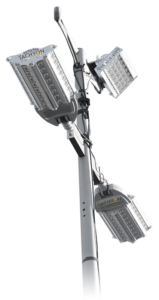1. The Significance of Energy-saving Renovation of Street Lights
Electric energy is an indispensable and important energy in social production and life. Due to the improvement of urbanization level and the expansion of industrial production scale, the consumption of electric energy in social production and life has also increased significantly. This has led to further aggravation of the energy shortage situation, and many cities have fallen into an energy crisis one after another. Obviously, this is very unfavorable to the long-term and healthy development of the social economy.
In the urban power network system, the street lighting system consumes a large proportion of electric energy. Therefore, the energy-saving renovation of street lights is conducive to reducing the total power consumption of the urban power system, thereby improving the energy crisis and promoting the stable and healthy development of the social economy.
In addition, the application of intelligent monitoring technology in the energy-saving renovation of street lights is conducive to the establishment of an information-based and digital service platform. The transmission of relevant data and information during the operation of the street lighting system to the urban road management department will help improve the management efficiency of road public facilities by managers. Thereby ensuring the safety, reliability and overall efficiency of the entire urban power grid.
At the same time, the energy-saving renovation of street lights is a significant manifestation of the national energy-saving policy. It can set a good example in the urban energy-saving transformation, thereby driving all the people of the city to participate in the activities of “energy saving, emission reduction, and low-carbon life”. And actively contribute to urban energy conservation, promote the improvement of energy utilization, and produce good economic and social benefits.
2. Common Types of Street Light Intelligent Monitoring Systems
2.1 Wireless network type
Wireless network control system is a relatively common type of street light intelligent monitoring system. At present, the wireless network-based control systems that are widely used in major cities mainly use the Internet and wireless local area networks to work.
For the IoT network, in nature, it belongs to the wireless sensor network. The wireless network street light lighting control system that uses this network to work is mainly based on Zig-Bee technology.
This technology is a new wireless network technology that has appeared in recent years. It has a low rate and is suitable for short-range wireless connections. In the process of operation, it is necessary to coordinate the relationship between the sensors to realize the continuous relay between the sensors. Through ZigBee technology, the functions of the intelligent lighting control system can be improved to achieve diversified purposes, such as automatic dimming, PWN dimming, etc.
Practice has proved that the wireless network street light monitoring system established by using ZigBee technology has the advantages of low energy consumption, low cost, high security, and convenient operation. As the technology continues to mature, its application scope will be further expanded.
2.2 Power line carrier type
There are many kinds of intelligent control systems for power line carrier type street lights. One of the most widely used is the intelligent control system based on the X-10 protocol. The so-called X-10 protocol refers to a communication protocol that uses power lines as the basic medium to remotely monitor electronic systems. Simply put, the power line carrier type intelligent control system is an intelligent lighting control system that transmits voice and data signals through power lines.
According to the different voltage levels, the power line carrier type intelligent control system can be mainly divided into three basic types: low voltage power line carrier communication, medium voltage power line carrier communication and high voltage power line carrier communication.
3. Design of Lighting Intelligent Monitoring System
3.1 Overview
The intelligent lighting monitoring system for urban street lights is mainly an intelligent system designed by using advanced technologies such as intelligent control technology, digital electronic technology, and mobile communication technology. For difficult-to-manage street lights, public lighting equipment, etc., control strategies for areas and road sections can be set in advance according to actual needs, seasonal and weather changes. Set the time on the computer in advance according to the strategy, and the system can automatically divide by time period, perform timing switch control by branch, and also perform real-time and manual switch control.
When the night (or the light is dim) comes and the traffic peak is in, the street lights are all turned on according to the rated operating voltage. After the peak traffic period, it is switched on proportionally at the economical operating voltage. It can also light up the key parts (areas) for prevention, not light up or less light in the safe areas (areas), and light up the places where there are activities and needs. Everything can be done easily by the operator on the computer. It not only saves manpower, but also eliminates contradictions and mistakes caused by human factors, effectively saving electric energy.
3.2 System Composition
The intelligent lighting monitoring system of urban street lights is mainly composed of three parts: monitoring center, communication network and remote control terminal. Among them, the remote control terminal is composed of a regulating voltage stabilizer cabinet and a remote controller. The main control room of the street light intelligent dimming monitoring system is located in the office of the street light management department, and the computer network intelligent remote control is implemented.
3.3 System principle
The street light intelligent monitoring system can be divided into three parts: the communication system, the control center main station, and each point measurement and control substation.
Communication is generally in the form of a combination of wired and wireless or wireless. The main station can be divided into two parts: computer and network, and its main function is to control and manage the operation of the entire system. It has strong compatibility. Each sub-site mainly constitutes its controller through various new technology equipment, so as to realize the functions of communication with the master station, execution switch, control time and feedback data.
There are many kinds of intelligent control street lights, but they all adopt the mode of “main station computer control center + appropriate communication means or methods + centralized intelligent controller of each substation + street light control system”.
4. Application of Intelligent Monitoring Technology of Street Lights in Energy-saving Renovation
4.1 Requirements for intelligent street light monitoring device
The street light intelligent monitoring device has a direct impact on the application effect of the monitoring technology. Therefore, the street light monitoring device must be equipped in strict accordance with the design scheme of the intelligent monitoring system:
① It is required that the data collector must collect the data information of each street light in time, and feed this information to the network system platform in real time, so that the relevant personnel can deal with it in time.
In addition to monitoring street light information, it is also necessary to monitor related intelligent network loop information and computer-controlled instructions and information.
② The installation of intelligent instruments for street lights must meet the standard requirements. All intelligent instruments should be installed in special boxes and equipped with special anti-theft locks. A scientific and reasonable control cable should be set under the smart street light, and the position of the cable should be controlled within the support rod.
③ The power line, network line and protective tube of the intelligent street light control system should be configured together. Only in this way can the coordination of the three functions be ensured.
④ The monitoring computer shall be reasonably arranged. Generally speaking, the monitoring computer should be arranged in the administrator’s office, and spare computer equipment must be set up.
4.2 Intelligent energy conservation standards and measures
The application of street light intelligent monitoring technology in energy-saving renovation must follow relevant energy-saving standards. Generally speaking, the intelligent energy-saving standards for street lights mainly include the following aspects:
① The intelligent control system should comprehensively consider energy saving and reliability, and automatically control and turn off less than half of the lights, but it must be ensured that the lights on both sides of the road in the longitudinal direction are kept on.
② The system should meet the requirements of automatically shutting down the power supply at night, so as to reduce the unnecessary power consumption of street lights in the middle of the night.
③ The intelligent system device should automatically cut off the power supply under the condition that the light within 100m can be seen clearly during the day, and the sun light gradually weakens in the evening, until the situation within 100m can not be clearly seen.
④ The intelligent system must have the function of adjusting the illuminance, and automatically adjust the illuminance of the street lights according to the different illumination levels at different times of the day, so as to achieve a better energy-saving effect.
⑤ It should be equipped with an automatic device to reduce the power of the light source to reduce power consumption in the middle of the night.
4.3 Analysis of Substation Application in Local Monitoring System
When designing a local intelligent monitoring system, factors such as energy-saving methods, street light models, and three-phase electric power distribution must be comprehensively considered. The switch control of street lights is the most important control module in the local intelligent monitoring sub-station. The control process of this module is as follows:
① A complete communication system should be established according to different levels of lighting needs.
② The timetable for the control of street lights in this area should be formulated according to the surrounding environment and other factors.
③ The sub-station shall store the switch light timetable information of each road section in a special memory, and the memory must have the rewriting function, so that the street light switch light can be adjusted according to the change of the situation.
5. Conclusion
In short, with the continuous development of science and technology, the level of intelligent monitoring technology for street lights has gradually improved. This will also play a certain role in promoting the quality of urban energy-saving renovation. Although the application level of street light intelligent monitoring technology is gradually improving, there are still some problems in the actual application process. Only by strengthening scientific research on intelligent monitoring technology and constantly summarizing practical experience can we fundamentally achieve the goal of energy-saving transformation.







